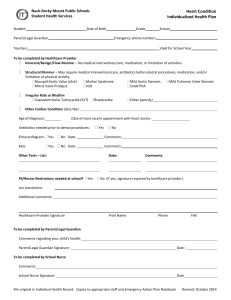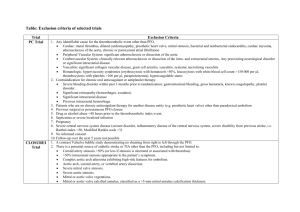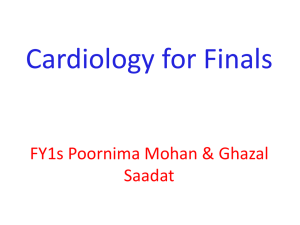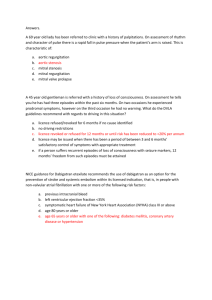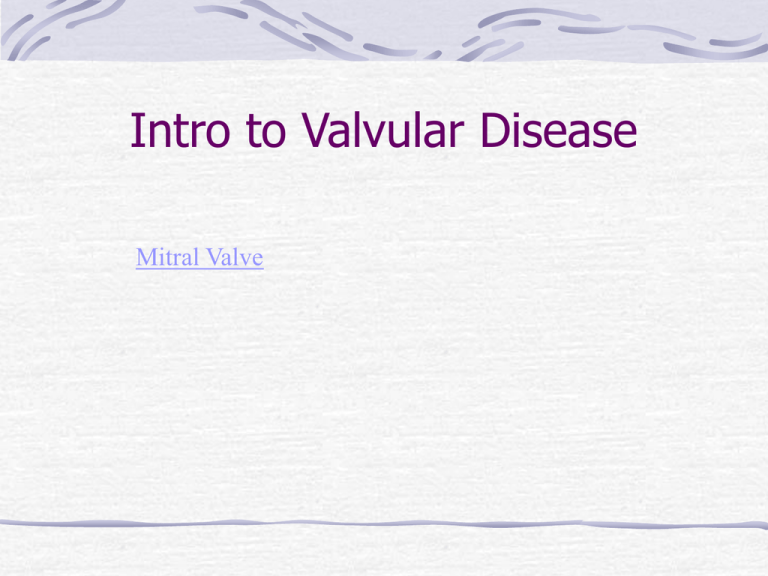
Intro to Valvular Disease
Mitral Valve
Valvular Heart Disease
Heart contains
Two atrioventricular valves
Mitral
Tricuspid
Two semilunar valves
Aortic
Pulmonic
Valvular Heart Disease
Types of valvular heart disease
depend on
Valve or valves affected
Two types of functional alterations
Stenosis
Regurgitation
Valvular Heart Disease
Valvular disorders occur in children and
adolescents primarily from congenital
conditions and in adults from
degenerative heart disease
Valvular Heart Disease
HeartPoint: Valvular Heart Disease
http://www.heartcenteronline.com/myheartdr/co
mmon/articles.cfm?ARTID=187
Flashcards about Ch 19 NETI KQ- on your own
Risk Factors
Rheumatic Heart Disease MI
Congenital Heart Defects
Aging
CHF
Valvular surgery
Heart Surgery Innovations - Google Video
11:22 valves
20 beating heart
20 aortic valve
Pathophysiology
Stenosis- narrowed valve, increases afterload
Regurgitation or insufficiency- increases
preload. The heart has to pump same blood
**Blood volume and pressures are reduced in
front of the affected valve and increased
behind the affected valve.
This results in heart failure
All valvular diseases have a characteristic
murmur murmurs
Mitral Valve Stenosis
Fig. 37-9
Fish mouth
Mitral Stenosis
Dec. flow into LV
LA hypertrophy
Pulmonary pressures increase
Pulmonary hypertension
Dec. CO
* early symptom is DOE
Later get symptoms of R heart failure
A fib is common- anticoagulants
Usually secondary to rheumatic fever
Mitral Regurgitation
Regurg of blood into LA during systole
LA dilation and hypertrophy
Pulmonary congestion
RV failure
LV dilation and hypertrophy-to
accommodate inc. preload and dec CO
Mitral Regurgitation
MitraClip Repair
MitraClip 3D Animation
Mitral Valve Prolapse
A type of mitral insufficiency
Usually asymptomatic- click murmur
May get atypical chest pain related to
fatigue
Tachydysrhythmias may develop
Risk for endocarditis may be increased
Mitral Valve Prolapse
Fig. 37-10
Mitral Valve Prolapse
Usually benign, but serious
complications can occur
Mitral valve regurgitation
Infective endocarditis
Sudden death
Cerebral ischemia
Mitral Valve Prolapse
Clinical manifestations
Most patients asymptomatic for life
Murmur from insufficiency that gets more
intense through systole
Late or holosystolic murmur
Clicks mid to late systole that may be
constant or vary beat to beat
Mitral Valve Prolapse
Dysrhythmias
Paroxysmal supraventricular tachycardia
Ventricular tachycardia
Palpitations
Lightheadedness
Dizziness
Mitral Valve Prolapse
May or may not be present with chest
pain
If pain occurs, episodes tend to occur in
clusters, especially during stress
Pain may be accompanied by dyspnea,
palpitations, and syncope
Does not respond to antianginal treatment
A&P 1 Heart part 1
Midsytolic click & late systolic murmur
MVP video
Infections & Injuries of the Heart- on own
Live Search Videos: mitral valve
prolapse
Aortic Stenosis
Aortic Stenosis
Minimally Invasive Aortic Heart
Valve Replacement
Aortic Stenosis
Aortic Stenosis
Increase in afterload
Reduced CO
LV hypertrophy
Incomplete emptying of LA
Pulmonary congestion
RV strain
Symptoms
Syncope
Angina
Dyspnea
This triad reflects left ventricular
failure
Aortic Stenosis
May be asymptomatic for many years
due to compensation
DOE, angina, and exertional syncope
are classic symptoms
Later get signs of R heart failure
Untreated-poor prognosis- 1020%sudden cardiac death
Aortic Valve Stenosis
Poor prognosis when experiencing
symptoms and valve obstruction is not
relieved
Nitroglycerin is contraindicated because it
reduces preload
New ApproachPercutaneous AVR
Aortic Regurgitation
Aortic Regurgitation
Get increased preoad- 60% of SV can
be regurgitated
Characteristic water hammer pulse
Regurgitation of blood into the LV
LV dilation and hypertrophy
Dec. CO
Echocardiography
Aortic Valve Regurgitation
Clinical manifestations
Sudden manifestations of cardiovascular
collapse
Left ventricle exposed to aortic pressure
during diastole
Weakness
Aortic Valve Regurgitation
Severe dyspnea
Chest pain
Hypotension
Constitutes a medical emergency
Water Hammer pulse
Pulse, water hammer: A jerky
pulse that is full and then collapses
because of aortic insufficiency
(when blood ejected into the aorta
regurgitates back through the aortic
valve into the left ventricle ).
Also called a Corrigan pulse or a
cannonball, collapsing, pistol-shot, or
trip-hammer pulse.
Austin Flint
Tricuspid and Pulmonic Valve
Disorders
Result in R side heart failure
Diagnostic Tests
Echo- assess valve motion and chamber
size
CXR
EKG
Cardiac cath- get pressures
Collaborative Care
Drug therapy
Digitalis
Diuretics
Antidysrhythmics
-Blockers
Anticoagulants
Medications
Like Heart Failure
ACE,
Dig
Diuretics
Vasodilators
Beta blockers
Anticoagulants
*Prophylactic antibiotics
Medical/ Surgical Treatment
Percutaneous balloon valvuloplasty
Surgery
Open commissurotomy- open stenotic
valves
Annuloplasty- can be used for both
Valve Replacement
Mechanical-need anticoagulant
Biologic-only last about 15 years
Ross Procedure
Collaborative Therapy
Surgical therapy for valve repair or
replacement
Valve repair is typically the surgical
procedure of choice
Valvular replacement may be required for
certain patients
Valve Replacement Surgery
MedlinePlus: Interactive Health Tutorials- on own
Ross Procedure
This is an excised porcine bioprosthesis. The main
advantage of a bioprosthesis is the lack of need for
continued anticoagulation. The drawback of this type of
prosthetic heart valve is the limited lifespan, on average from
5 to 10 years (but sometimes shorter) because of wear and
calcification.
This is a mechanical valve prosthesis of the more modern tilting
disk variety (for the mitral valve). Such mechanical prostheses
will last indefinitely from a structural standpoint, but the patient
requires continuing anticoagulation because of the exposed nonbiologic surfaces.
Nursing Diagnoses
Activity intolerance
Excess fluid volume
Decreased cardiac output
Ineffective therapeutic regimen
management
What Is New?
•Surgeons are exploring heart valve replacement
without the need for open heart surgery. Typically,
diseased or defective valves are replaced with an
artificial valve or a tissue valve (from a pig or cow). A
new, less invasive procedure, known as percutaneous
transcatheter heart valve implantation, involves the
use of balloon catheters and large stents introduced
through a puncture in the skin (in the groin area,
near the femoral vein). The new heart valve is
transported via the stent to the site, where the stent
is then expanded to implant the valve. For patients
not able to undergo open-heart surgery, due to age
and/or physical condition, percutaneous heart valve
implantation may impact significantly on survival and
quality of life.
New Approach to Valvular Surgery
Case study
New Cont.
A number of new technologies are being
explored to allow patients who formerly would
need an open-heart surgery to have a lessinvasive procedure. For instance, the use of a
tiny metallic clip is being studied for the
treatment of mitral regurgitation to help the
valve close properly.
Cont.
Though they may last a lifetime for older
patients, younger patients may need several
replacement procedures over time.
Therefore, one focus of research is to create
longer-lasting replacement valves,
particularly for patients with congenital heart
disease. Two areas of research have shown
potential toward this goal: stem cell research
and the use of endothelial cells.
Cardiomyopathy
Condition is which a ventricle has
become enlarged, thickened or
stiffened.
As a result heart’s ability as a pump is
reduced
Fig. 37-12
Cardiomyopathy
Primary-idiopathic
Secondary
Ischemia- from CAD
infectious disease
exposure to toxins-alcohol, cocaine
Metabolic disorders
Nutritional deficiencies
Pregnancy
3 Types of Cardiomyopathy
Dilated
Hypertrophic
Restrictive
Fig. 37-13
Pathophysiology
Dilated
Most common- heart failure in 25-40%
Cocaine and alcohol abuse
Chemotherapy, pregnancy
Hypertension
Genetic
* Heart chamber dilate and contraction is
impaired and get dec. EF%
*Dysrhythmias are common- SVT Afib and VT
Prognosis poor-need transplant
This very large heart has a circular shape
because all of the chambers are dilated. It
felt very flabby, and the myocardium was
poorly contractile. This is an example of a
cardiomyopathy.
Normal weight 350 gms now 700 gms
Pathophysiology
Hypertrophic-HCM
Genetic
Also known as IHSS or HOCM
Get hypertrophy of the ventricular mass and
impairs ventricular filling and CO
Symptoms develop during or after physical
activity
Sudden cardiac death may be first symptom
Symptoms are dyspnea, angina and syncope
HCM Patho
1.
2.
3.
4.
Massive ventricular hypertrophy
Rapid, forceful contraction of the LV
Impaired relaxation or diastole
Obstruction to aortic outflow
Primary defect is diastolic filling
**HCM most common cause of SCD in young
adulthood
Fig. 37-14
Copyright © 2007, 2004, 2000, Mosby, Inc., an affiliate of Elsevier Inc. All Rights Reserved.
There is marked left ventricular hypertrophy, with asymmetric
bulging of a very large interventricular septum into the left
ventricular chamber. This is hypertrophic cardiomyopathy. About
half of these cases are genetic. Both children and adults can be
affected, and sudden death can occur.
HCM- Symptoms
Dyspnea
Fatigue- dec. CO
Angina Syncope
S4 and systolic murmur
Hypertrophic Diagnostics
Echo- TEE
Heart Cath
Treatment of HOCM
PTSMA- alcohol induced percutaneous
trans luminal septal myocardial ablation
- inject alcohol into small branch of LAD
which causes ischemia and MI of septal wall.
(Grey’s Anatomy episode relief of heart
failure)
cardiomyopathy - Live Search Video
Interventions
Goal- improve vent filling and relieve LV
outflow obstruction
Beta blockers- metoprolol
Calcium channel blockers
Dig- only for A-fib if present
Anti-arrhythmics- amiodorone or sotalol
ICD- to dec. risk of sudden death
AV pacing
Surgical Treatment
Ventriculomyotomy and myomectomyincising the septum muscle and
removing some of the hypertrophied
muscle
Nursing
Relieve symptoms
Prevent complications
Provide pysch and emotional support
TeachingAvoid strenuous exercise and dehydration
Avoid anything increasing the SVR (afterload)
makes obstruction worse
If chest pain- rest and elevation of feet for venous
return
Avoid vasodilators like nitroglycerine- decrease
venous return to the heart
Pathophysiology
Restrictive
Least common
Rigid ventricular walls that impair filling
Contraction and EF normal
Signs of CHF
Prognosis-poor
Diagnostics
Echo-wall motion and EF
EKG
CXR
Hemodynamics
Perfusion scan
Cardiac cath
Myocardial biopsy
Medications
Same as for heart failure except for
hypertrophic
Treatment
Surgery
Vad-bridge to transplant
Heart Transplant
Myloplasty
ICD- antiarrhythmics are negative inotropes
Dual chamber pacemaker
Hypertrophic- excision of ventricular septummyotomy, inject denatured alcohol in
coronary artery that feeds the top portion of
septum.
Heart transplant
virtual transplant
Nursing Diagnoses
Decreased Cardiac Output
Fatigue
Ineffective Breathing Pattern
Fear
Ineffective Role Performance
Anticipatory grieving
Priority Question # 29
During the initial post-operative assessment of a
patient who has just transferred to the postanesthesia care unit after repair of an abdominal
aortic aneruysm all of these data are obtained. Which
has the most immediate implications for the client’s
care?
A. The arterial line indicates a blood pressure of
190/112.
B. The monitor shows sinus rhythm with frequent
PAC’s.
C. The client does not respond to verbal stimulation.
D. The client’s urine output is 100ml of amber urine.
Priority Question #30
It is the manager of a cardiac surgery unit’s job to develop a
standardized care plan for the post-operative care of client
having cardiac surgery. Which of these nursing activities
included in the care plan will need to be done by an RN?
A. Remove chest and leg dressings on the second post-operative
day and clean the incisions with antibacterial swabs.
B. Reinforce patient and family teaching about the need to deep
breathe and cough at least every 2 hours while awake.
C. Develop individual plan for discharge teaching based on
discharge medications and needed lifestyle changes.
D. Administer oral analgesisc medications as needed prior to
assisting patient out of bed on first post-operative day.
Priority Question # 25
These clients present to the ER complaining of acute abdominal
pain. Prioritize them in order of severity.
A. A 35 year old male complaining of severe, intermittent
cramps with three episodes of watery diarrhea, 2 hours after
eating.
B. An 11 year old boy with a low-grade fever, left lower
quadrant tenderness, nausea, and anorexia for the past 2 days.
C. A 40 year old female with moderate left upper quadrant pain,
vomiting small amounts of yellow bile, and worsening symptoms
over the past week.
D. A 56 year old male with a pulsating abdominal mass and
sudden onset of pressure-like pain in the abdomen and flank
within the past hour.
Case study 15
Ms. C. 81y/o admitted to CCU with SOB. She has a hx of
mitral valve regurgitation with left ventricular enlargement.
She received 100mg lasix IV in ER and her dyspnea improved.
She has O2 at 3L/min. She has crackles bibasilar and monitor
is SR rate 94-96 with occ. PVC’s. The only med ordered is
MSO4 2-4mg IV as needed for chest pain or dyspnea.
As you go to assess her you find her in bed at 60 degree angle.
She is pale, has circumoral cyanosis and respirations are rapid
and labored.
Question 1
What action should you take first?
1. Listen to breath sounds
2. Ask when the dyspnea started
3. Increase her O2 to 6L minute
4. Raise the HOB to 75-85 degrees
Cont.
Upon assessment, you find crackles and
she is coughing pink frothy sputum. Her
O2 sat is 85% with O2 increased to
6L/min. She has 3-4+ pitting edema in
her feet and mid- calf. She has JVD with
HOB elevated to 75 degree angle.
Case Study 15- #2
Which one of these complications are
you most concerned about, based on
your assessment?
1. Pulmonary edema
2. Cor pulmonale
3. Myocardial infarction
4. Pulmonary embolus
#3
Which action will you take next?
1. Call the physician about client’s condition.
2. Place client on a non-rebreather mask with
FiO2 at 95%.
3. Assist client to cough and deep breathe.
4. Administer ordered morphine sulfate 2mg
IV.
#4
What additional assessment data are
most important to obtain at this time?
1. Skin color and capillary refill
2. Orientation and pupil reaction to light
3. Heart sounds and PMI
4. Blood pressure and apical pulse
#5
Client’s B/P is 98/52 and AP is 116 and
irregular in ST rate 110-120 with frequent
multifocal PVC’s. You call the physician and
receive these orders. Which one should be
done first?
1. Obtain serum dig level
2. Give furosemide 100mg. IV
3. Check blood potassium level
4. Insert #16 french foley catheter
#6
Which order could be assigned to an
LVN?
1. Obtain serum digoxin level
2. Give furosemide 100mg. IV
3. Check blood potassium level
4. Insert #16 french foley catheter
#7
While you are waiting for the the potassium
level, you give morphine sulfate 2mg IV to
the the client. A new graduate asks why you
are giving her the morphine. What is the best
response?
1. It will help prevent any chest pain from
occurring.
2. It will decrease her respiratory rate.
3. It will make her more comfortable if she
has to be intubated.
4. It will decrease venous return to her heart.
#8
Her K is 3.1. the physician orders KCL 20meq. IV
before giving the furosemide. How will you
administer it.
1. Utilize a syringe pump to infuse the KCL over 10
minutes.
2. Dilute the KCL in 100 ml of D5W and infuse over 1
hour.
3. Use a 5ml syringe and push the KCL over at least
1 minute.
4. Add the KCL to 1 liter of D5W and administer over
8 hours.
#9
After you have infused the KCL, you give the
lasix. Which of these nursing actions will be
most useful in evaluating whether the lasix is
having the desired effect?
1. Obtain the client’s daily weight
2. Measure the hourly urine output
3. Monitor blood pressure
4. Assess the lung sounds
#10
The physician orders a natrecor 100mcg IV
bolus and an infusion of 0.5 mcg/ min. Which
assessment data is most important to monitor
during the infusion?
1. Lung sounds
2. Heart rate
3. Blood pressure
4. Peripheral edema
#11
Which nurse should be assigned care for this
client?
1. A float RN who has worked on CCU step
down for 9 years and has floated before to
CCU
2. An RN from a staffing agency who has 5
years CCU experience and is orienting to your
CCU today
3. A CCU RN who is already assigned to care
for a newly admitted client with chest trauma
4. The new graduate RN who needs more
experience in caring for client with left
ventricular failure.
A few days later, she is transferred to the step-down
unit. Her weight has decreased 4 kg. She denies SOB
at rest, has crackles only in the bases. She is
receiving O2 at 1L/min. She has a grade III/IV
murmur and her pulse is very irregular. The monitor
shows atrial fibrillation, rate 80-100. She denies
dizziness, but states her vision feels “fuzzy.” She has
2+ ankle edema. VS are B/P 108/62, 86, 24, O2 sat
95%.
Medications:
Lasix 40mg twice daily
KCL 10mEq daily
Aspirin 81mg daily
Captopril 6.25mg tid
Digoxin 0.25mg daily’
#12
Which information would be most
important to report to the physician?
1. Crackles and oxygen saturation
2. Atrial fibrillation and fuzzy vision
3. Apical murmur and pulse rate
4. Peripheral edema and weight
#13
All meds are scheduled for 9 AM. Which
would you hold until you discuss it with
the physician?
Furosemide 40mg po bid
Ecotrin 81mg po daily
KCL 10meq three times a day
Captopril 6.25mg po three times a day
Lanoxin .125mg po every other day


